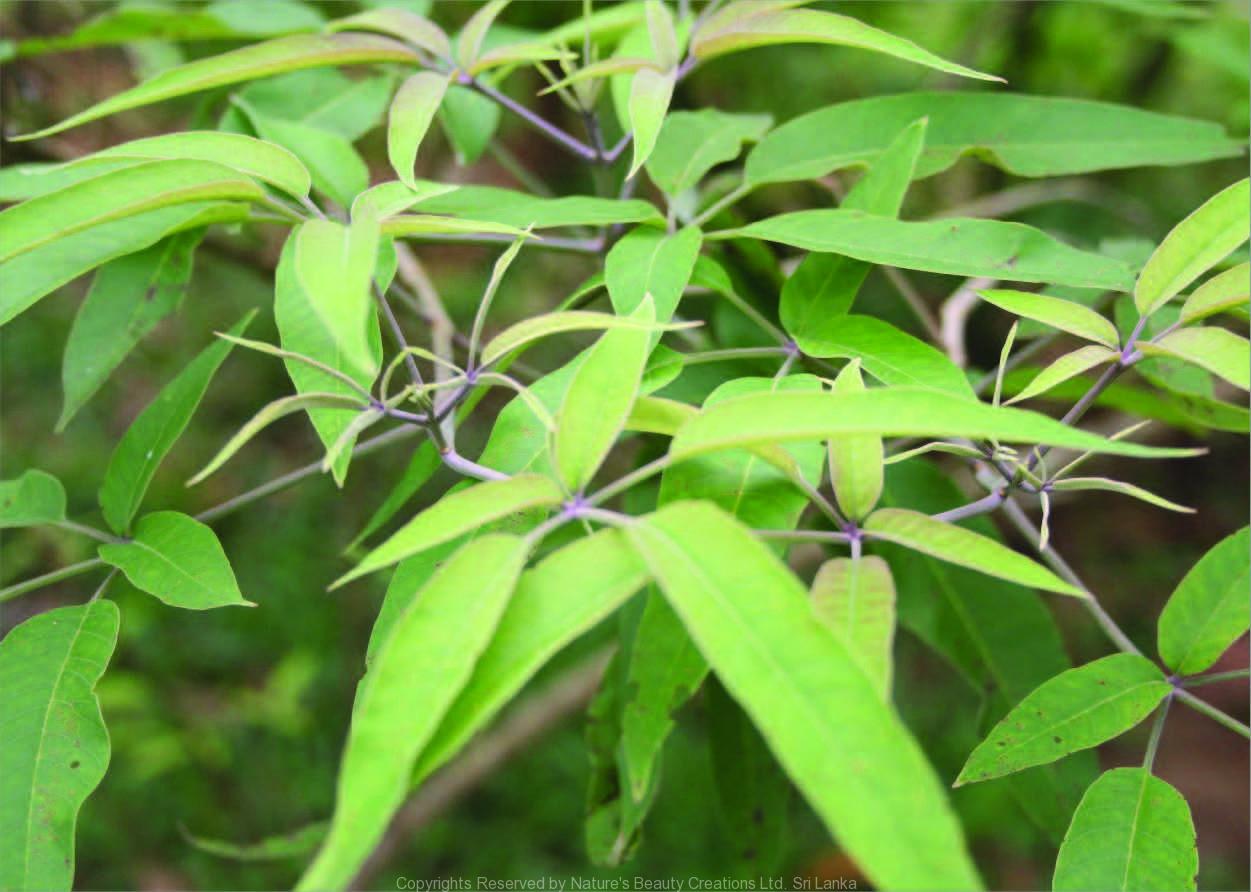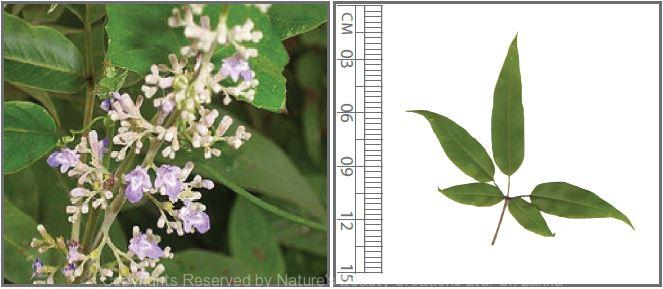

Traditional Knowledge
Useful plant parts :
Leaf, young shoot, root and bark
Uses in traditional medicine :
- Steamed leaves are applied on swollen joints
- Decoction of young leaves is taken for cough and cold
- Steam of immature shoots is inhaled to cure headaches, catarrh and sinuses
- Used as an analgaesic and an antiseptic
- Taken for flatulence
- Soothes wounds
Scientific Research
Chemical constituents:
Iridoid glycoside: negundoside, flavonoid: vitexicarpin, long chain hydrocarbon: hentriacontanol and β-sitosterol from leaves; terpenes: negundol, negunfural, negundonorins A and B, betulinic acid, ursolic acid from seeds and leaves
Bioactivity :
Aqueous and alcohol extracts of leaves: anti-inflammatory, analgaesic, antihistamine, central nervous system depressant activity, antifungal, anticonvulsant; essential oils from fresh leaves, flowers and dried fruits: antibacterial; methanol extract of roots: snake venom neutralizing activity; alcohol extract of seeds: hepatoprotective; vitexicarpin: cytotoxic; polar fractions of plant: antioxidative; butanol extract of plant: antitussive
Clinical:
References : Alam, M. I. and Gomes, A., (2003), Snake venom neutralization by Indian medicinal plants (Vitex negundo and Emblica officinalis) root extracts, Journal of Ethnopharmacology, 86(1), 75–80. Avadhoot, Y. and Rana, A. C., (1991), Hepatoprotective effect of Vitex negundo against carbon tetrachloride-induced liver damage, Biomedical and Life Sciences, 14(1), 96-98. Chandramu, C. et al., (2003), Isolation, characterization and biological activity of betulinic acid and ursolic acid from Vitex negundo L, Phytother. Res, 17, 129–134. Dharmasiri, M. G. et al., (2003), Anti-inflammatory and analgesic activities of mature fresh leaves of Vitex negundo, Journal of Ethnophar- macology, 87(2–3), 199–206. Díaz, F. et al., (2003), Cytotoxic Flavone Analogues of Vitexicarpin, a Constituent of the Leaves of Vitex negundo, Journal of Natural Products, 66(6), 865–867. Gupta, M. et al., (1999), CNS activity of Vitex negundo Linn. in mice, Indian Journal of ExperimentalBiology, 37(2), 143-6. Haq, R. U. et al., (2012), Antitussive and toxicological evaluation of Vitex negundo, Nat Prod Res, 26(5), 484-8. Huang, J. et al., (2013), Two new glycosides from Vitex negundo, Nat Prod Res. Khokra, S. L. et al., (2008), Essential Oil Composition and Antibacterial Studies of Vitex negundo Linn. Extracts, Indian J Pharm Sci, 70(4), 522–526. Nagarsekar, K. S. et al., (2011), Antioxidant and antilipid peroxidation potential of supercritical fluid extract and ethanol extract of leaves of Vitex negundo linn, Indian J Pharm Sci, 73(4), 422-9. Sathiamoorthy, B. et al., (2007), New antifungal flavonoid glycoside from Vitex negundo, Bioorganic & Medicinal Chemistry Letters, 17(1), 239–242. Sharma, R. L. et al., (2009), A new iridoid glycoside from Vitex negundo Linn (Verbenacea), Nat Prod Res, 23(13), 1201-9. Sundaram, R. et al., (2012), Antihyperglycemic effect of iridoid glucoside, isolated from the leaves of Vitex negundo in streptozotocin- induced diabetic rats with special reference to glycoprotein components, Phytomedicine, 19(3-4), 211-6. Tandon, V. R. and Gupta, R. K., (2005), An experimental evaluation of anticonvulsant activity of Vitex negundo, Indian Journal of Physiology and Pharmacology, 49(2), 199-205. Tasduq, S. A. et al., (2008), Negundoside, an irridiod glycoside from leaves of Vitex negundo, protects human liver cells against calcium- mediated toxicity induced by carbon tetrachloride, World J Gastroen- terol, 14(23), 3693-709. Tiwari, O. P. and Tripathi, Y. B., (2007), Antioxidant properties of different fractions of Vitex negundo Linn., Food Chemistry, 100(3), 1170–1176. Zheng, C. J. et al., (2012), A new labdane diterpene from Vitex negundo, Pharm Biol, 50(6), 687-90. Zheng, C. J. et al., (2012) Sesquiterpenoids and norterpenoids from Vitex negundo, Fitoterapia, 83(1), 49-54
Copyrights Reserved By
Natures Beauty Creations




